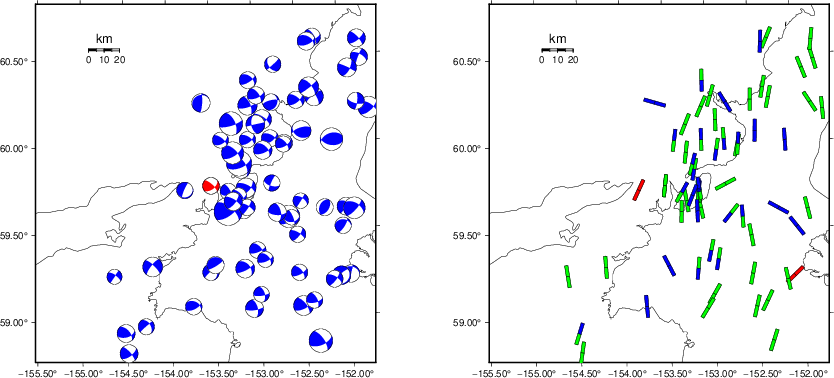Location
Location ANSS
The ANSS event ID is ak020a5v6uly and the event page is at
https://earthquake.usgs.gov/earthquakes/eventpage/ak020a5v6uly/executive.
2020/08/08 22:54:20 59.770 -153.525 142.1 4 Alaska
Focal Mechanism
USGS/SLU Moment Tensor Solution
ENS 2020/08/08 22:54:20:0 59.77 -153.52 142.1 4.0 Alaska
Stations used:
AK.CAPN AK.CNP AK.GHO AK.HOM AK.L18K AK.L19K AK.L22K
AK.M20K AK.N18K AK.N19K AK.O18K AK.O19K AK.P17K AK.PWL
AK.Q19K AK.RC01 AK.SKN AK.SLK AK.SWD AT.PMR AV.ACH AV.ILSW
AV.SPU AV.STLK II.KDAK TA.M16K TA.M17K TA.M22K TA.N17K
TA.O15K TA.O16K
Filtering commands used:
cut o DIST/3.3 -40 o DIST/3.3 +50
rtr
taper w 0.1
hp c 0.03 n 3
lp c 0.10 n 3
Best Fitting Double Couple
Mo = 2.11e+22 dyne-cm
Mw = 4.15
Z = 158 km
Plane Strike Dip Rake
NP1 313 74 143
NP2 55 55 20
Principal Axes:
Axis Value Plunge Azimuth
T 2.11e+22 37 269
N 0.00e+00 50 113
P -2.11e+22 12 8
Moment Tensor: (dyne-cm)
Component Value
Mxx -1.98e+22
Mxy -2.37e+21
Mxz -4.51e+21
Myy 1.31e+22
Myz -1.07e+22
Mzz 6.79e+21
-------- ---
------------ P -------
--------------- ----------
#-----------------------------
########--------------------------
############-----------------------#
###############---------------------##
###################-----------------####
#####################--------------#####
########################-----------#######
###### #################--------########
###### T ###################-----#########
###### ####################--###########
############################--##########
##########################-----#########
######################---------#######
##################-------------#####
############-------------------###
------------------------------
----------------------------
----------------------
--------------
Global CMT Convention Moment Tensor:
R T P
6.79e+21 -4.51e+21 1.07e+22
-4.51e+21 -1.98e+22 2.37e+21
1.07e+22 2.37e+21 1.31e+22
Details of the solution is found at
http://www.eas.slu.edu/eqc/eqc_mt/MECH.NA/20200808225420/index.html
|
Preferred Solution
The preferred solution from an analysis of the surface-wave spectral amplitude radiation pattern, waveform inversion or first motion observations is
STK = 55
DIP = 55
RAKE = 20
MW = 4.15
HS = 158.0
The NDK file is 20200808225420.ndk
The waveform inversion is preferred.
Magnitudes
Given the availability of digital waveforms for determination of the moment tensor, this section documents the added processing leading to mLg, if appropriate to the region, and ML by application of the respective IASPEI formulae. As a research study, the linear distance term of the IASPEI formula
for ML is adjusted to remove a linear distance trend in residuals to give a regionally defined ML. The defined ML uses horizontal component recordings, but the same procedure is applied to the vertical components since there may be some interest in vertical component ground motions. Residual plots versus distance may indicate interesting features of ground motion scaling in some distance ranges. A residual plot of the regionalized magnitude is given as a function of distance and azimuth, since data sets may transcend different wave propagation provinces.
ML Magnitude

Left: ML computed using the IASPEI formula for Horizontal components. Center: ML residuals computed using a modified IASPEI formula that accounts for path specific attenuation; the values used for the trimmed mean are indicated. The ML relation used for each figure is given at the bottom of each plot.
Right: Residuals from new relation as a function of distance and azimuth.

Left: ML computed using the IASPEI formula for Vertical components (research). Center: ML residuals computed using a modified IASPEI formula that accounts for path specific attenuation; the values used for the trimmed mean are indicated. The ML relation used for each figure is given at the bottom of each plot.
Right: Residuals from new relation as a function of distance and azimuth.
Context
The left panel of the next figure presents the focal mechanism for this earthquake (red) in the context of other nearby events (blue) in the SLU Moment Tensor Catalog. The right panel shows the inferred direction of maximum compressive stress and the type of faulting (green is strike-slip, red is normal, blue is thrust; oblique is shown by a combination of colors). Thus context plot is useful for assessing the appropriateness of the moment tensor of this event.
Waveform Inversion using wvfgrd96
The focal mechanism was determined using broadband seismic waveforms. The location of the event (star) and the
stations used for (red) the waveform inversion are shown in the next figure.
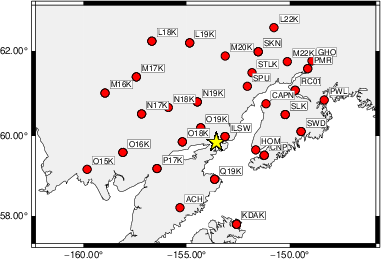
|
|
Location of broadband stations used for waveform inversion
|
The program wvfgrd96 was used with good traces observed at short distance to determine the focal mechanism, depth and seismic moment. This technique requires a high quality signal and well determined velocity model for the Green's functions. To the extent that these are the quality data, this type of mechanism should be preferred over the radiation pattern technique which requires the separate step of defining the pressure and tension quadrants and the correct strike.
The observed and predicted traces are filtered using the following gsac commands:
cut o DIST/3.3 -40 o DIST/3.3 +50
rtr
taper w 0.1
hp c 0.03 n 3
lp c 0.10 n 3
The results of this grid search are as follow:
DEPTH STK DIP RAKE MW FIT
WVFGRD96 90.0 60 45 25 4.06 0.4632
WVFGRD96 92.0 55 50 20 4.07 0.4807
WVFGRD96 94.0 55 50 20 4.08 0.4978
WVFGRD96 96.0 55 50 20 4.08 0.5114
WVFGRD96 98.0 55 50 20 4.08 0.5232
WVFGRD96 100.0 55 50 20 4.09 0.5325
WVFGRD96 102.0 55 50 20 4.09 0.5409
WVFGRD96 104.0 55 50 20 4.09 0.5503
WVFGRD96 106.0 55 50 20 4.09 0.5588
WVFGRD96 108.0 55 50 20 4.10 0.5654
WVFGRD96 110.0 55 50 20 4.10 0.5706
WVFGRD96 112.0 55 50 20 4.10 0.5750
WVFGRD96 114.0 55 50 20 4.10 0.5810
WVFGRD96 116.0 55 50 20 4.10 0.5867
WVFGRD96 118.0 55 50 20 4.11 0.5911
WVFGRD96 120.0 55 50 20 4.11 0.5931
WVFGRD96 122.0 55 50 20 4.11 0.5957
WVFGRD96 124.0 55 50 20 4.11 0.5996
WVFGRD96 126.0 55 55 20 4.12 0.6022
WVFGRD96 128.0 55 55 20 4.12 0.6026
WVFGRD96 130.0 55 55 20 4.12 0.6058
WVFGRD96 132.0 55 55 20 4.12 0.6072
WVFGRD96 134.0 55 55 20 4.12 0.6073
WVFGRD96 136.0 55 55 20 4.13 0.6099
WVFGRD96 138.0 55 55 20 4.13 0.6105
WVFGRD96 140.0 55 55 20 4.13 0.6100
WVFGRD96 142.0 55 55 20 4.13 0.6121
WVFGRD96 144.0 55 55 20 4.13 0.6122
WVFGRD96 146.0 55 55 20 4.13 0.6115
WVFGRD96 148.0 55 55 20 4.14 0.6132
WVFGRD96 150.0 55 55 20 4.14 0.6123
WVFGRD96 152.0 55 55 20 4.14 0.6138
WVFGRD96 154.0 55 55 20 4.14 0.6142
WVFGRD96 156.0 55 55 20 4.14 0.6129
WVFGRD96 158.0 55 55 20 4.15 0.6148
WVFGRD96 160.0 55 55 20 4.15 0.6134
WVFGRD96 162.0 55 55 20 4.15 0.6139
WVFGRD96 164.0 55 55 20 4.15 0.6128
WVFGRD96 166.0 55 55 20 4.15 0.6120
WVFGRD96 168.0 55 55 20 4.16 0.6119
The best solution is
WVFGRD96 158.0 55 55 20 4.15 0.6148
The mechanism corresponding to the best fit is
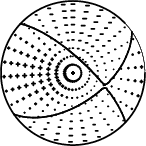
|
|
Figure 1. Waveform inversion focal mechanism
|
The best fit as a function of depth is given in the following figure:
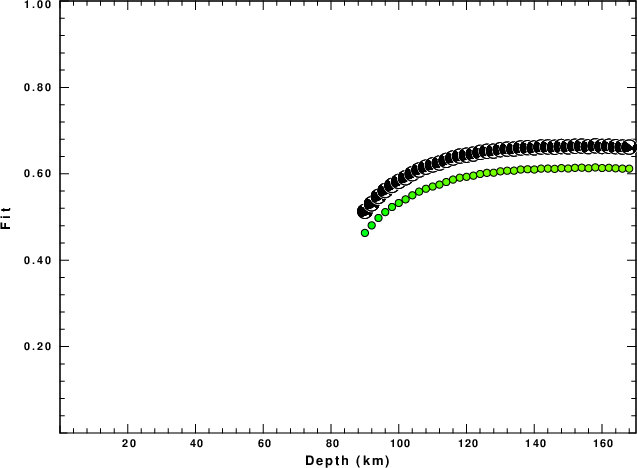
|
|
Figure 2. Depth sensitivity for waveform mechanism
|
The comparison of the observed and predicted waveforms is given in the next figure. The red traces are the observed and the blue are the predicted.
Each observed-predicted component is plotted to the same scale and peak amplitudes are indicated by the numbers to the left of each trace. A pair of numbers is given in black at the right of each predicted traces. The upper number it the time shift required for maximum correlation between the observed and predicted traces. This time shift is required because the synthetics are not computed at exactly the same distance as the observed, the velocity model used in the predictions may not be perfect and the epicentral parameters may be be off.
A positive time shift indicates that the prediction is too fast and should be delayed to match the observed trace (shift to the right in this figure). A negative value indicates that the prediction is too slow. The lower number gives the percentage of variance reduction to characterize the individual goodness of fit (100% indicates a perfect fit).
The bandpass filter used in the processing and for the display was
cut o DIST/3.3 -40 o DIST/3.3 +50
rtr
taper w 0.1
hp c 0.03 n 3
lp c 0.10 n 3
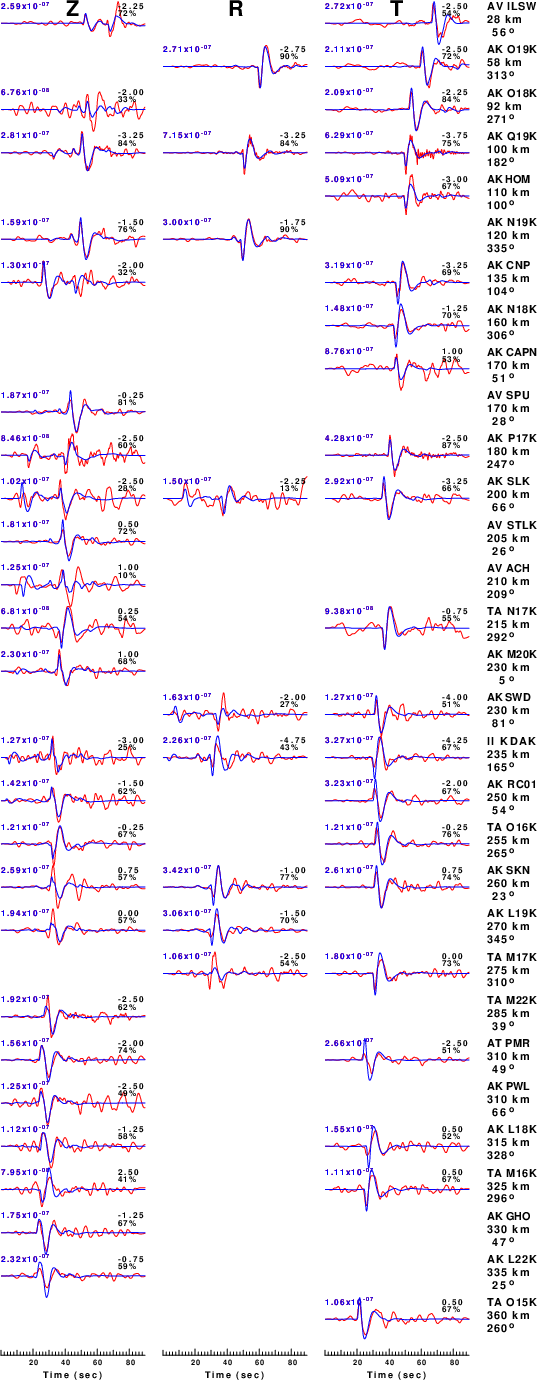
|
|
Figure 3. Waveform comparison for selected depth. Red: observed; Blue - predicted. The time shift with respect to the model prediction is indicated. The percent of fit is also indicated. The time scale is relative to the first trace sample.
|
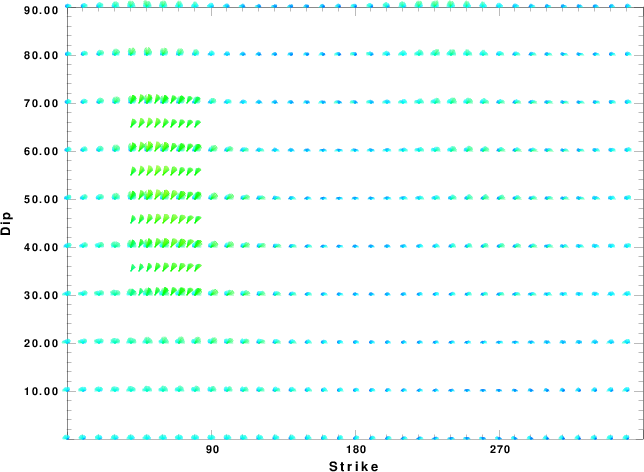
|
|
Focal mechanism sensitivity at the preferred depth. The red color indicates a very good fit to the waveforms.
Each solution is plotted as a vector at a given value of strike and dip with the angle of the vector representing the rake angle, measured, with respect to the upward vertical (N) in the figure.
|
A check on the assumed source location is possible by looking at the time shifts between the observed and predicted traces. The time shifts for waveform matching arise for several reasons:
- The origin time and epicentral distance are incorrect
- The velocity model used for the inversion is incorrect
- The velocity model used to define the P-arrival time is not the
same as the velocity model used for the waveform inversion
(assuming that the initial trace alignment is based on the
P arrival time)
Assuming only a mislocation, the time shifts are fit to a functional form:
Time_shift = A + B cos Azimuth + C Sin Azimuth
The time shifts for this inversion lead to the next figure:
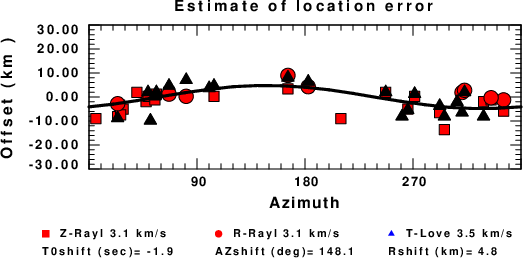
The derived shift in origin time and epicentral coordinates are given at the bottom of the figure.
Velocity Model
The WUS.model used for the waveform synthetic seismograms and for the surface wave eigenfunctions and dispersion is as follows
(The format is in the model96 format of Computer Programs in Seismology).
MODEL.01
Model after 8 iterations
ISOTROPIC
KGS
FLAT EARTH
1-D
CONSTANT VELOCITY
LINE08
LINE09
LINE10
LINE11
H(KM) VP(KM/S) VS(KM/S) RHO(GM/CC) QP QS ETAP ETAS FREFP FREFS
1.9000 3.4065 2.0089 2.2150 0.302E-02 0.679E-02 0.00 0.00 1.00 1.00
6.1000 5.5445 3.2953 2.6089 0.349E-02 0.784E-02 0.00 0.00 1.00 1.00
13.0000 6.2708 3.7396 2.7812 0.212E-02 0.476E-02 0.00 0.00 1.00 1.00
19.0000 6.4075 3.7680 2.8223 0.111E-02 0.249E-02 0.00 0.00 1.00 1.00
0.0000 7.9000 4.6200 3.2760 0.164E-10 0.370E-10 0.00 0.00 1.00 1.00
Last Changed Thu Apr 25 08:28:04 PM CDT 2024


